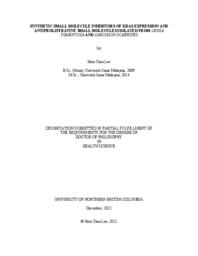Li, Wai Ming
Person Preferred Name
Wai Ming Li
Related Works
Content type
Digital Document
Description / Synopsis
Small molecules, including synthetic and those isolated from natural products, are important classes of compounds with broad utility, including drugs. The objectives of this dissertation were (i) to synthesize, purify, and characterize novel small molecule inhibitors on KRAS expression level; (ii) to purify and characterize antiproliferative small molecules from Onnia tomentosa and Sarcodon Scabripes. The first part of this Ph.D. dissertation focuses on synthesizing dispiropyrrolidizine derivatives with potential KRAS protein expression inhibitory activity. At the outset of this study, compound UNBC 152, which turned out to be a mixture of compounds, was found to possess bioactivities including antiproliferative activity and the ability to inhibit KRAS expression. This study aimed to synthesize UNBC 152 and resolve the compound-activity ambiguity. The investigation on UNBC 152 led to the isolation of two novel regioisomers, 6 and 7. Regioisomers 6 and 7 were synthesized using a one-pot three-component 1,3-dipolar cycloaddition reaction. They were purified using recrystallization method and their structures were determined by FTIR, ESI-LRMS, NMR, and X-ray crystallography. Regioisomers 6 and 7 showed the ability to inhibit KRAS protein expression. Over the past several decades, researchers have isolated many useful medicinal compounds from mushrooms. Medicinal mushrooms with validated anticancer properties in animals have been found and this has encouraged further exploration of fungal metabolites with antiproliferative activity. The second part of this Ph.D. dissertation focuses on isolating antiproliferative small molecules from two species of mushrooms native to British Columbia (BC). Chapters 3 and 4 described the use of antiproliferative activity-guided approach that led to the isolation and structural elucidation of small molecules from O. tomentosa and S. scabripes native to Northern BC. The ethanolic extracts of O. tomentosa and S. scabripes were purified using phase separation, Sephadex LH-20, and HPLC-based fractionation. The final structure of the small molecules was determined by ESI-LRMS, ESI-HRMS/MS, and NMR. Fatty acids (labeled 1.1-1.4 and 2-7) were identified from the ethanolic extract of O. tomentosa, while several p-terphenyl derivatives (1-4) and one phenolic aldehyde (5) were identified from S. scabripes. Amongst the small molecules, oleic acid (7), linoleic acid (6), and linoleic degradation products from O. tomentosa, and compounds 1-5 from S. scabripes showed antiproliferative activity against HeLa cervical cancer cells.
Origin Information

